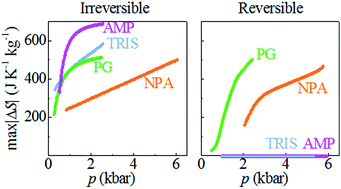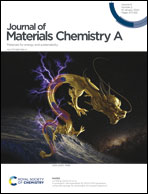Reversible and irreversible colossal barocaloric effects in plastic crystals
Abstract
The extremely large latent heat exchanged in phase transitions involving strong molecular orientational disordering has recently led to the proposal of plastic crystals as a feasible solution for solid-state barocaloric eco-friendly cooling technologies. Here we determine the reversible barocaloric response of four plastic crystals derived from neopentane [C(CH3)4]: (NH2)C(CH2OH)3 (TRIS for short), (NH2)(CH3)C(CH2OH)2 (AMP), (CH3)C(CH2OH)3 (PG) and (CH3)3C(CH2OH) (NPA). All of them display colossal entropy changes at their ordered-plastic phase transition, which is a primal requirement for competitive barocaloric materials. However, we show that it is also important to verify that the large barocaloric effects can be achieved using pressures that, while being moderate, are large enough to overcome the pressure-dependent hysteresis. From this quantity and using the quasi-direct method, we determine the minimum pressure needed to achieve reversible barocaloric effects, prev, for each compound. Specifically, we find a small and moderate prev for PG and NPA, respectively, which therefore display colossal reversible barocaloric effects comparable to harmful fluids used in current refrigerators and thus confirm the potential of plastic crystals as excellent alternatives. Instead, in TRIS and AMP, the obtained prev is excessive to yield reversible barocaloric effects useful for cyclic applications.



 Please wait while we load your content...
Please wait while we load your content...